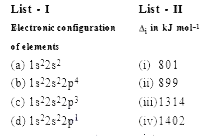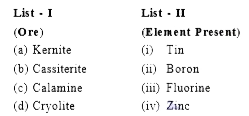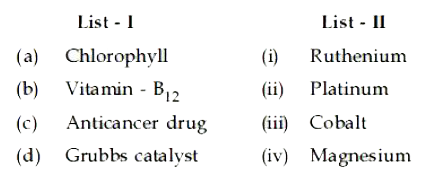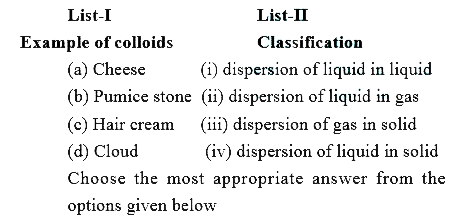Given below are two statement
Statement I:SbCl5 is more covalent than SbCl3 Statement I:The higher oxides of
In the light of above, statements, choose the most appropriate answer from the options given below.
Both statement I and statement II are correct
statement I is incorrect but statement II is correct
statement I is correct but Statement II is incorrect
Both Statement I and Statement II are incorrect
To solve the question, we need to analyze both statements provided and determine their validity.
Step 1: Analyze Statement I
Statement I: SbCl5 is more covalent than SbCl3.
1. Understanding Covalency: Covalent character in compounds is influenced by the polarization of the bond. Polarization occurs when a cation (positive ion) is attracted to an anion (negative ion) and can distort its electron cloud.
2. Oxidation States: In SbCl5, antimony (Sb) is in the +5 oxidation state, while in SbCl3, it is in the +3 oxidation state.
3. Size of Cation: The +5 oxidation state of Sb results in a smaller cation compared to the +3 oxidation state. A smaller cation leads to greater polarization of the anion (Cl^-), resulting in a more covalent character.
4. Conclusion for Statement I: Since SbCl5 has a higher charge density due to the +5 oxidation state, it is indeed more covalent than SbCl3. Thus, Statement I is True.
Step 2: Analyze Statement II
Statement II: The higher oxides of halogens tend to be more stable than the lower ones.
1. Understanding Oxides of Halogens: Halogens can form various oxides, and their stability can vary with the oxidation state of the halogen.
2. Oxidation States and Stability: Higher oxidation states (e.g., +7 in ClO−3, BrO−3, etc.) tend to be more stable than lower oxidation states (e.g., +1 in ClO, BrO). This is because higher oxidation states allow for better stabilization through resonance and the presence of electronegative atoms.
3. Conclusion for Statement II: As the oxidation state increases, the stability of the oxides also increases due to the ability of the halogen to stabilize higher positive charges. Therefore, Statement II is also True.
Final Conclusion
Both statements are true. Hence, the most appropriate answer is that both statements are correct.
Answer:
Both statements are true.
---
Statement I: SbCl5 is more covalent than SbCl3.
2. Oxidation States: In SbCl5, antimony (Sb) is in the +5 oxidation state, while in SbCl3, it is in the +3 oxidation state.
Statement II: The higher oxides of halogens tend to be more stable than the lower ones.
Both statements are true. Hence, the most appropriate answer is that both statements are correct.
Both statements are true.
Topper's Solved these Questions
Similar Questions
Knowledge Check
- Question 1 - Select One
Match List - I with List- II

Choose the most appropriate answer from the options given below -A(a)→(ii),(b)→(iii),(c)→(iv),(d)→(i)B(a)→(i),(b)→(iv),(c)→(iii),(d)→(ii)C(a)→(i),(b)→(iii),(c)→(iv),(d)→(ii)D(a)→(iv),(b)→(i),(c)→(ii),(d)→(iii) - Question 2 - Select One
Match List - I with List- II

Choose the most appropriate answer from the options given below -A(a)→(i),(b)→(iii),(c)→(iv),(d)→(ii)B(a)→(ii),(b)→(i),(c)→(iv),(d)→(iii)C(a)→(ii),(b)→(iv),(c)→(i),(d)→(iii)D(a)→(iii),(b)→(i),(c)→(ii),(d)→(iv)
Match List-I with List -II

Choose the most appropriate answer from the options given below:View SolutionMatch List - I with List - II.

Choose the most appropriate answer from the options given below :View SolutionMatch List - I with List - II.

Choose the most appropriate answer from the options given below :View SolutionMatch List -I with List -II :

Choose the most appropriate answer from the options given below :View SolutionMatch List - I with List - II.

Choose the most appropriate answer from the options given below :View SolutionMatch List - I with List - II

Choose the most appropriate answer from the options given below :View Solution



